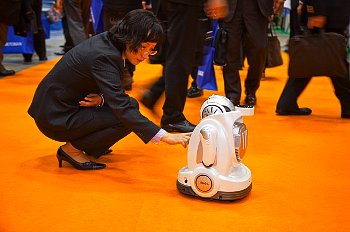Is Apple Making Us Japanese?

Everyone is mesmerized by Apple’s ability to revolutionize the way we think about IT products. With the iPhone, for example, Apple has morphed a mere communication device into a platform that includes a music player, a video recorder, a note transcriber, and the capacity to handle thousands of other apps that each bring the phone tantalizingly close to a personal computer.
But Apple is doing something far more radical to us as a nation, something that might even outlive the innovative firm itself: it is singlehandedly transforming us into a society that will one day feel comfortable having emotional relationships with machines.
At first glance, emotional connectedness to machines sounds like an outlandish statement. Americans have a very utilitarian relationship with machines: they use the microwave to heat food, the dishwasher to clean dirty dishes, and the lawn mower to groom the lawn. With the exception of cars, we consider machines to basically be cold objects. Our movies and literature are full of images that support this attitude: whether our five-year olds are watching cartoons on Sunday, or we’re enjoying a Friday night movie at the cinema, we’re watching robots and machines that are monstrous and destructive (even the sleek small ones in James Bond movies wreak havoc). Most of the Western Europe also shares this uncomfortable relationship with machines, which is largely the result of an emotionally wrenching industrial revolution that brought efficiency and automation, but also dislocation, income redistribution, and alienation.
The Japanese stand in stark contrast to us. They are exceptionally fond of their machines, which are without exception small and beautifully designed, even cute. Whether it’s their legendary programmable toilets or their meticulously compact coffeemakers, Japanese household machines fit seamlessly into their environment— man and machine locked in a harmonious tango. Japanese homes also contain electronic gadgets that are far from functional, but are just cute and pleasant to have around. Some single women in Japan come home and tell their pink electronic teddy bears if they had a bad day at work. Grown men in the subway carry around cell phones with little dolls attached to them that make noises if you press them. Japanese anime is full of cute little robots like the phenomenally popular cartoon character Astro Boy that nurture the close bond between humans and machines from a very young age.
The Japanese are not weird. On the contrary, they are quite forward-looking in their comfort with co-existing with machines. By 2050, we should all expect small helper robots in our homes, and the sooner we get used to entrusting them with our information and tasks, the more productive we’ll become. But today, the distance between our aloof attitude and that of the Japanese seems insurmountable. Yet Steve Jobs is nudging us along this very direction. How? Because he doesn’t care if you only feel comfortable thinking of a machine as a mere functional gadget: he will create products that you will like having around in your home.
When it comes to disruptive technologies, innovation guru Clay Christenson cautioned firms that good managers fail to innovate because they are too focused on what their customers want, and customers only want improvements on what they have and what they like. Steve Jobs doesn’t fall into this Innovator’s Dilemma, as Christenson calls it, because he simply doesn’t listen to his customers. He doesn’t bother with user tests in which customers explain how they would like products improved: he selects an A+ design and user experience team that imagines what the next great product will be and then he tells manufacturers in China to make it. The result: customers get something beautiful and multi-faceted that they didn’t expect and they fall in love. Read that line again: they fall in love. By designing beautiful personalized gadgets, Jobs is inadvertently and perhaps even consciously making us love small machines with which we will cohabitate in our homes.
Have you noticed that the way your friends treat their Macs is different from the way they treat their PCs? People actually wipe their Macs clean and take pains to choose the color of their Nano, they are excited when the iPad is released, and when their iPhone breaks, they feel sad not only because it costs money but they really liked their iPhone.
The new field of social robotics is popping up in every major university and company research lab: millions of dollars are being invested to make sophisticated robots that people will buy because they are human-like in appearance. But Apple is proving the Japanese belief that machines have to be neither very smart nor look like humans to elicit emotional attachment. They just need to be extremely helpful, sleek and beautiful.
Ayesha and Parag Khanna explore human-technology co-evolution and its implications for society, business and politics at The Hybrid Reality Institute.





